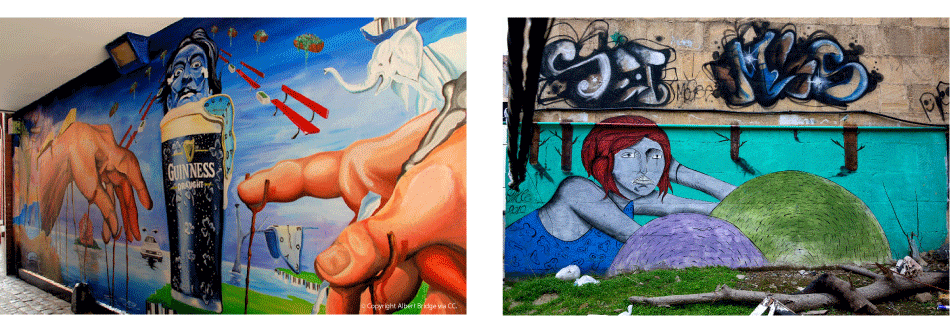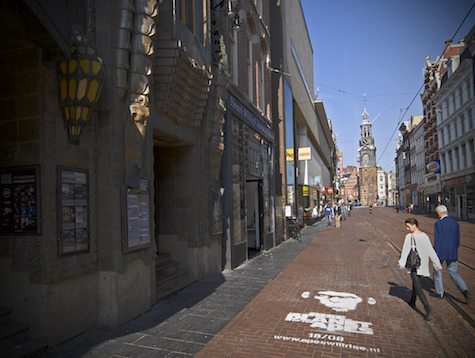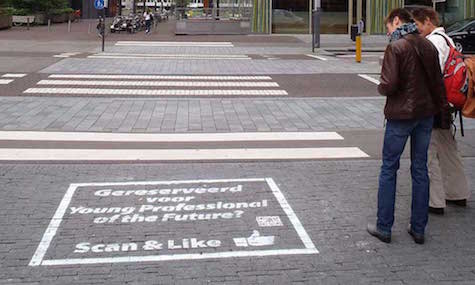Paint The Town [Green]: Pigment-Based Natural Media
By Jim Bowes, Guest Blogger | April 6, 2016
In the past I’ve talked about using water, sand and snow and ice to create outdoor advertisements. This time around, I’ll reveal tips and tricks to help marketers generate messages with the pigment-and-binder solutions known to laymen as “paint.”
The first thing you should know about his technique is that it involves applying various kinds of paint to buildings, sidewalks and other parts of the built environment. The second thing you should know is that it’s generally illegal.
The Inconsistent Arm of the Law
A November 2014 study conducted by the City of Savannah compared definitions of “graffiti” and “mural” in several US cities. The results varied greatly.
In Tarrytown, NY, the term graffiti denotes an “intent to damage” the property upon which it’s created. In Greensboro, NC, graffiti includes any rendering on private or public property that is “not authorized or permitted by the property owner.” Greensboro does allow, however, for “temporary, easily removable chalk or other water soluble markings… used in connection with traditional children’s activities…[or] any lawful business.”
Denver, CO, definitions explicitly address business, defining a mural as “one-of-a-kind” art that doesn’t appear “in any other public form including…advertising, logos, and trademarks.” Milwaukee, WI, also requires murals contain “no copy, lettering, symbols or any references directly related to the promotion of any product, business or service.”
Most of the cities examined distinguish between installations that undergo an approval process and those that don’t. While Denver and Milwaukee explicitly forbid companies to use these mediums, other municipalities seem to account only for the “vandalism” versus “art” debate, failing to even acknowledge the possibility of advertisement through pigment application in a public space.

Can you tell which of these murals is partially illegal in Denver?
I personally have used these techniques only when I had permission from either the municipality or private property owners. Strangely enough, roughly 20% of the work I’ve done with natural media was on behalf of local governments that didn’t allow companies to execute similar campaigns.
If you’re really determined to run your business sustainably, I encourage you to explore whether there’s an opportunity for you to use natural media mediums like paints in your community. Read up on local legislation and seek clarification from local officials. You might even be able to encourage the introduction of provisions allowing for natural media messaging.
We’re not yet at the point where the general public has decried the wastefulness of traditional outdoor advertisements. Still, businesses authentically committed to sustainable operations shouldn’t wait for the public or the media to call them out on their inconsistencies – they should proactively seek to realize eco-friendly alternatives.
Sign Up for Pegable Post to get ideas, advice and resources on activating your Purpose sent right to your inbox.
The Problem With Traditional Outdoor Media
If you’ve read my other guest posts you already understand the scale of the problem and should feel free to skip ahead. If you haven’t read my other posts and you use outdoor advertising, start by glancing through the stats below:
- Traditional outdoor advertising produces millions of tons of waste each year. (ECOBOARD Report)
- Countries in Europe alone throw away over 150 million square meters of outdoor ad paper every year. If that were a one-meter wide piece of paper, it would wrap around our planet 3.9 times. (ECOBOARD Report)
- Most billboard ads only run for 2 – 4 weeks before they’re thrown away. (ECOBOARD Report)
- Some types of digital billboards can consume as much electricity in a year as 29 average US households! (Digital Signage Study)
I admit that this data is outdated and spotty but it’s all there is. Right now, it’s impossible to understand the global impact of disposable outdoor advertisements.
Even without an account of the total damage, it’s clear that traditional outdoor advertising is wasteful. I’m curious how much longer this format will remain acceptable to a population of consumers increasingly concerned with sustainability.
Painting The Town Green
While some companies use spray paint as the medium for graffiti-style outdoor advertisements, paints in aerosol cans are notoriously bad for the environment. Luckily, there are several eco-friendly paints you can use to share your messages outdoors (Click To Tweet!). The tools you’ll need aren’t devoid of their own environmental impact, but they last a long time and generating more impressions isn’t tied to generating more waste.
Templates
Most natural media techniques can be mastered in less than 30 minutes and rely on a template. Templates are made using digitally guided equipment so that logos and other visual elements that make up a brand’s identity are reproduced faithfully.
One template will help you reproduce your message hundreds – if not thousands – of times. Combined with the cost of the paints themselves, templates enable you to spread your message far and near for [roughly] less than a dollar a print.
The Paint
There are three main types of eco-friendly paint being used these days: milk paint, chalk paint and clay paint. Here’s what you should know about them. They:
- Are either water-based or solvent-based
- Are generally applied using either a spray can or a home latex spray system (available at most hardware stores)
- Won’t adhere as well to very smooth surfaces like marble or polished stone
- Can be purchased in a variety of premixed colors or as colorless mediums
- Are removable
While water-based paints are more sustainable, they work best when it is dry and warm so that they can dry in a reasonable amount of time. In damp or cold weather you’ll have to wait a good while for your images to dry. If you don’t protect your work when it is wet, you can be sure someone will walk right over it and leave an unsightly trail of footprints down the sidewalk. I’ve used burners to dry water-based paint when conditions weren’t ideal but must emphasize that heat can warp your templates, compromising the integrity of your prints.
With this general information out of the way, I’ll dive into the specifics of each paint option.
Milk

Natural media always turns heads 😉 Image courtesy of Green Graffiti.
Milk paint is my favorite of the bunch. It’s been used for thousands of years and archeologists even found artifacts decorated with milk paint when they excavated King Tutenkhamen’s tomb! Milk paint is made from milk and lime stone. These days, it comes in a powdered form. All you need to do is add a little water and a colored pigment and you are ready to go.
Most natural pigments are made from ground minerals. With sustainable house products gaining popularity, professional paint stores will be able to advise you about which pigments will not contaminate the groundwater where you paint your message. To learn which minerals make up which pigment colors, you can check out this handy art chart.
Milk paint images will generally last for a few weeks but you can prolong their life by adding a bit of nut oil to the paint. I’ve created milk paintings using nut oil that lasted as long as 6 months.
Chalk

This chalk message on the sidewalk in Amsterdam even has a QR code! Image courtesy of Green Graffiti.
Chalk and clay paints are very similar. Chalk paints are created with one end use in mind: making marks on sports fields. These paints have to meet strict requirements that make them very sustainable. One of the requirements is that they cannot contaminate the ground water. Given the cost of maintaining the grass on professional sports fields and the huge stake owners have in players’ wellbeing, you can be sure chalk paints are very gentle.
They come in a large variety of colors and can be water or solvent-based. Just do a search for “line marking chalk” and you will find several brands to choose from.
Clay
Clay paints are generally used to paint interior walls of peoples’ homes. They are nontoxic and do not contain harmful chemicals. Clay paints can be found in powder or liquid form and most professional paint stores carry several brands. Some come in a base white color to which you can add pigments while others come premixed in a variety of hues.
I have also seen companies create outdoor advertisements with tempera paints. Since they’re made with mineral pigments and eggs, they’re safe for children and safe for mother nature. I’m sure there are other kinds of binders and pigments available but the above are the mainstays and should certainly be enough to get you started.
Application
Applying paints with a spray gun is by far the easiest and fastest way to work. Any home spray-painting system will work well as long as you mix the paint so that it is on the thin side. Look for a home spraying system that is made for latex. Oil-based spraying systems will clog as the paint is just too thick. Keep in mind that you will need a power source for these. Usually a small generator is more than enough.
I’ve experimented with self-contained, battery-powered sprayers. They work fine as long as you’re spraying but if you are traveling between different locations, the paint will dry and you might find yourself cleaning your sprayer more than spraying your message.
Line-marking systems will also get the job done. These are specially modified garden sprayers. The spray is not as fine as a paint sprayer and it takes some getting used to, but they’re conveniently powered by hand pump and don’t require a power source.
Applying paint with a paint roller is also an option but it requires a very thin template and I find that the paint often gets stuck under the template, ruining the print. For this reason, I feel that spraying is the best method of application.
Removal
Most of these paints will come off using a bit of water, a wire brush and some elbow grease. They’ll come off even more easily with a power-washer. You might need an eco-friendly graffiti remover to remove some paints completely. Test paint application and removal before you finally place your images because some paints are much harder to remove than others.
I hope I’ve inspired you to explore what kinds of advertisements your target municipalities allow and possibly advocate for greater accommodation for less wasteful techniques. Encouraging the adoption of alternative outdoor advertising is an important way to limit the waste that comes with marketing and a necessary step for companies that define themselves by their sustainable behaviors.
Main Image Courtesy of Curb Media. Thanks Curb!




Dear Alison and RoundPeg,
Co-creating this series of blog posts with you has been a wonderful experience. You have a magical way of turning the okay into fabulous!